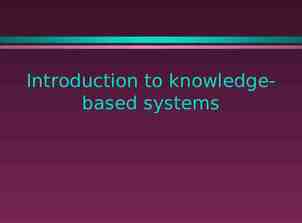Water Purification and Wastewater Treatment
32 Slides571.50 KB
Water Purification and Wastewater Treatment
Water Purification Screening Chlorination, fluoridation Chemical application – Aluminum sulfate (“alum”) Coagulation – Activated charcoal Removes objectionable tastes and odors
Water Purification Mixing Basins – Alum chemically reacts to form “floc” Gelatinous particles – Water in mixing basins is stirred Promotes collisions betwen floc particles – Floc particles grow in size Entrain bacteria and sediment
Water Purification Settling Basins – Flocculated material settles out and is piped to wastewater treatment plant Sand Filters – Hydrated lime added to minimize corrosion – Polishing operation
Water Purification Temporary storage in clear wells Filtered-water reservoir – Chlorination – Caustic soda to minimize corrosiveness of polished water – Gravity flow to pumping stations
Wastewater Treatment Septic Tanks – Bacteria in sewage degrade organic matter – Tank buried in ground to treat sewage from an individual home – Wastewater flows into tank
Septic Tank System
Wastewater Treatment Septic Tanks – Solid material (“sludge”) settles to bottom of tank – Cleaner water flows out of tank into ground through subsurface drains
Wastewater Treatment Lagoons (Stabilization Ponds) – 3-5’ deep – Sunlight, algae, oxygen interact to clean wastewater
Wastewater Treatment Conventional Sewage Treatment – Processes Collection Treatment
Wastewater Treatment Conventional Sewage Treatment – Processes Collection – Sewers Combined Separate
Stormwater and Sanitary Sewer System
Wastewater Treatment Conventional Sewage Treatment – Processes Collection – Combined Sewers Carry stormwater and wastewater – Separated Sewers Sanitary Sewers Storm Sewers
Wastewater Treatment Conventional Sewage Treatment – Processes Collection – – – – – Household sewer Lateral sewer Main sewers Interceptors Wastewater treatment plant
Wastewater Treatment Conventional Sewage Treatment – Processes Collection – High rainfall events Some wastewater may be diverted to receiving streams
Wastewater Treatment Conventional Sewage Treatment – Processes Treatment – Function To speed up natural processes by which water purifies itself DO is the key!
Wastewater Treatment Conventional Sewage Treatment – Processes Treatment – Processes Primary Secondary Advanced
The Wastewater Treatment Process
Wastewater Treatment Conventional Sewage Treatment – Processes Primary Treatment – Mechanical process Screening Grinding Grit Chamber (heavy particles - “grit”) Sedimentation Tank (suspended solids “sludge”) Chlorination of effluent
Wastewater Treatment Conventional Sewage Treatment – Processes Secondary Treatment – Biological process Uses bacteria to removed ODW and lower BOD – Types Trickling Filter Activated Sludge
Wastewater Treatment Conventional Sewage Treatment – Processes Secondary Treatment With Trickling Filters – Effluent leaves sedimentation tank and flows through trickling filters Bed of stones 3-10’ deep through which sewage passes Bacteria gather on stones and multiply, consuming ODW Cleaner water trickles through pipes at bottom of filter for additional treatment
Wastewater Treatment Conventional Sewage Treatment – Processes Secondary Treatment With Activated Sludge – Effluent leaves sedimentation tank and is pumped to an aeration tank – Effluent is mixed with air and sludge loaded with bacteria (“activated sludge”) – Sludge contacts with raw sewage, and bacteria in the sludge then decompose the raw sewage, lowering ODW and BOD
Wastewater Treatment Conventional Sewage Treatment – Processes Secondary Treatment With Activated Sludge – Activated sludge-sewage mixture is called mixed liquor – Mixed liquor leaves aeration tank and flows to another sedimentation tank where suspended solids settle out for reuse as activated sludge – Effluent is chlorinated – Activated sludge in sedimentation tank is reused
Wastewater Treatment Conventional Sewage Treatment – Processes Advanced (Tertiary) Wastewater Treatment – Physical and chemical processes that specific pollutants left in wastewater after primary and secondary treatment – Extremely costly! It cost twice as much to build a tertiary treatment plant compared to a secondary treatment plant
Wastewater Treatment Conventional Sewage Treatment – Processes Advanced (Tertiary) Wastewater Treatment – Processes Bleaching to remove coloration Disinfection to kill pathogens Coagulation-sedimentation with alum Adsorption using activated charcoal Electrodialysis for salt removal
Wastewater Treatment Conventional Sewage Treatment – Processes Sludge Disposal – – – – Landfills Incineration Land application Anaerobic digestion
Wastewater Treatment Water Quality Protection – Federal Laws Clean Water Act (1977) Water Quality Act (1987) U.S. Safe Drinking Water Act (1974)
Wastewater Treatment Water Quality Protection – Clean Water Act To restore and/or maintain the chemical, physical, and biological integrity of the nation’s surface waters
Wastewater Treatment Water Quality Protection – Safe Drinking Water Act Required USEPA to establish drinking water standards (“Maximum Contaminant Levels”) for any pollutant that MAY have adverse effects on human health No MCLs established for some SOCs, radioactive materials, toxic metals, and ptahogens
Wastewater Treatment Water Quality Protection – Natural Resources Defense Council Study Drinking water of 50 million Americans exceeds one or more MCL standards Most people have not been notified when their drinking water was contaminated Contaminated drinking water is responsible for 7 million ilnesses and 1200 deaths per year
Wastewater Treatment U.S. Water Quality Facts – 44% of lakes, 37% rivers, 32% estuaries still unsafe for fishing, swimming, other recreational uses





































